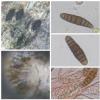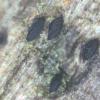
04-04-2025 11:56
 Edvin Johannesen
Edvin Johannesen
These 0.2-0,4 mm diam. flat to slightly convex, gr

03-04-2025 21:31
 Francois Guay
Francois Guay
Hi, I found this interesting ascomycete on incuba

03-04-2025 18:26
Lennert GeesHello there!I found this species on dung of an unk

03-04-2025 16:45
Me mandan el material seco de Galicia (España),

01-04-2025 23:18
Yanick BOULANGERBonsoirRécolté par un ami sur dans un tas de bra

29-03-2025 09:08
 Martine Vandeplanque
Martine Vandeplanque
Bonjour.J’ai essayé d’étudier un Daldinia.Qu

30-03-2025 10:24
Gonzalez Garcia MartaGood morning, I would like to know the opinion of
I have unsuccessfully tried to determine with the key Key to hysterioid fungi on bark and wood in Scandinavia, AGARICA vol. 42 103.
substrate: Picea, rotten wood, pretty much brittle, on bark
Fruiting body / habit / growth form: immersed, black, like a little mussle
Spores 1: 31.2 - 40.6 x 8.5 - 10.2 µm - Q: 3.55 - 4.10 (Ø LxB: 34.8 x 9.2 ØQ:3.8 N: 9)
Spores 2: 31.6 - 37.9 x 8.4 - 10.2 µm - Q: 3.31 - 4.32 (Ø LxB: 34.3 x 9.3 ØQ:3.7 N: 9)
Spore characteristics: 7-9fach septated, ends on old spores sometimes a little bit brighter
Ascus: biseriat
Paraphyses: filamentous
Spores : brown
Congo red: negativ
Melzers reagent: IKI-
https://fungi.myspecies.info/all-fungi/oedohysterium-insidens
according to Zogg (1962) and other authors the spores don't match perfectly but come close. they are brown and the number of cells fits.
Best regards from Bavaria
Till
I'm having trouble seeing if the ascomata are hysterioid-shaped or mytilinidioid-shpaed.
From what I can see it would be more like mytilinidioid.
A vertical section would be useful.
Thus your fungus grows on Picea. And at last, ascospores don't match. I join a paper to compare with the true Oedhysterium insidens.
I think your fungus belongs to Mytilinidiaceae.
And as I'm preparing a thesis on the subject, I'd be very happy to study it.
If you'd be willing to send me as much material as you can, here's my address:
Alain GARDIENNET
14 rue roulette
21260 VERONNES (France)
If you want you can contact me at : agardiennet@gmail.com. It's a very interesting find
I wonder if it could be a lophiostomataceous fungus, maybe something around Lophiostoma macrostomoides. A vertical section of the ascomata would indeed help, as you said, Alain. But soon we will know more!
Best wishes,
Gernot
Thanks,Alain
PS : Verpa bohemica is already there, Morchella deliciosa perhaps, I will check this afternoon. Morels or mussels , that's a question :)


 Oedohysterium-insidens-0001.pdf
Oedohysterium-insidens-0001.pdf